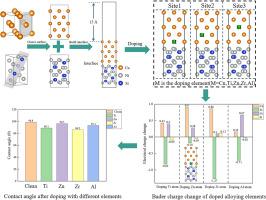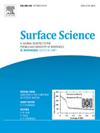合金元素(Ti、Zn、Zr、Al)对 Cu/Ni2Si 界面特性的影响:DFT 研究
IF 2.1
4区 化学
Q3 CHEMISTRY, PHYSICAL
引用次数: 0
摘要
在金属基复合材料中添加痕量合金元素对其界面结合性能和强度有重要影响。本研究在原子尺度上系统研究了掺杂合金元素的 Cu/Ni2Si 界面的电子结构、界面稳定性和结合性能。研究发现,在 Cu(100)/Ni2Si(101)-Ni 界面的 Cu 侧添加合金元素可提高界面稳定性,其中 Ti、Zn、Zr 和 Al 可使界面粘附功分别从 2.53 J/m2 增加到 3.04 J/m2、2.65 J/m2、3.20 J/m2 和 2.82 J/m2。在次界面层和第三界面层掺入合金元素时,只有 Zr 能显著提高界面稳定性。界面结构和电子结构分析表明,Ti 和 Zr 通过强化学键稳定了 Cu(100)/Ni2Si(101) 界面,而 Zn 和 Al 则降低了界面畸变能。界面的热力学稳定性随着掺杂率的提高而增加。此外,粘附力的增加往往会提高异质界面的润湿性。当界面层的掺杂率为 16.6% 时,Ti 和 Zr 对接触角的影响最大,分别从 98.8° 减小到 89.1° 和 86.2°,从而促进了润湿过程。本文章由计算机程序翻译,如有差异,请以英文原文为准。

Effect of alloying elements (Ti, Zn, Zr, Al) on the interfacial properties of Cu/Ni2Si: A DFT study
The addition of trace alloying elements to metal matrix composites has an important effect on their interfacial bonding properties and strength. In this study, the electronic structure, interfacial stability, and bonding properties of Cu/Ni2Si interfaces with doping alloying elements are systematically investigated on the atomic scale. It was found that the addition of alloying elements to the Cu side of the Cu(100)/Ni2Si(101)-Ni interface improved the interfacial stability, where Ti, Zn, Zr, and Al increased the interfacial work of adhesion from 2.53 J/m2 to 3.04 J/m2, 2.65 J/m2, 3.20 J/m2, and 2.82 J/m2, respectively. When alloying elements were doped in the sub-interfacial and third interfacial layers, only Zr enhances interfacial stability significantly. Analyses of interfacial and electronic structures show that Ti and Zr stabilize the Cu(100)/Ni2Si(101) interface through strong chemical bonds, while Zn and Al reduce interface distortion energy. The thermodynamic stability of the interface increases with higher doping rates. Moreover, increased adhesion tends to enhance the wettability of heterogeneous interfaces. At a 16.6% doping rate of the interfacial layer, Ti and Zr have the most significant effect on the contact angle, reducing it from 98.8° to 89.1° and 86.2°, respectively, thus promoting the wetting process.
求助全文
通过发布文献求助,成功后即可免费获取论文全文。
去求助
来源期刊

Surface Science
化学-物理:凝聚态物理
CiteScore
3.30
自引率
5.30%
发文量
137
审稿时长
25 days
期刊介绍:
Surface Science is devoted to elucidating the fundamental aspects of chemistry and physics occurring at a wide range of surfaces and interfaces and to disseminating this knowledge fast. The journal welcomes a broad spectrum of topics, including but not limited to:
• model systems (e.g. in Ultra High Vacuum) under well-controlled reactive conditions
• nanoscale science and engineering, including manipulation of matter at the atomic/molecular scale and assembly phenomena
• reactivity of surfaces as related to various applied areas including heterogeneous catalysis, chemistry at electrified interfaces, and semiconductors functionalization
• phenomena at interfaces relevant to energy storage and conversion, and fuels production and utilization
• surface reactivity for environmental protection and pollution remediation
• interactions at surfaces of soft matter, including polymers and biomaterials.
Both experimental and theoretical work, including modeling, is within the scope of the journal. Work published in Surface Science reaches a wide readership, from chemistry and physics to biology and materials science and engineering, providing an excellent forum for cross-fertilization of ideas and broad dissemination of scientific discoveries.
 求助内容:
求助内容: 应助结果提醒方式:
应助结果提醒方式:


